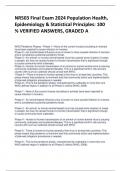NR503 Final Exam 2024 Population Health,
Epidemiology & Statistical Principles: 100
% VERIFIED ANSWERS, GRADED A
WHO Pandemic Phases - Phase 1—None of the current viruses circulating in animals
have been reported to cause infection in humans.
Phase 2—An animal-based influenza virus is known to have caused infection in humans
and is considered a potential pandemic threat.
Phase 3—An animal- or human-animal-based virus has caused some clusters of cases
in people, but has not caused human-to-human transmission that is significant enough
to cause community-level outbreaks.
Phase 4—Human-to-human transmission of an animal or human-animal virus is causing
community outbreaks and sustained disease. This is a significant shift in risk and any
country with such an outbreak should consult with WHO.
Phase 5—There is human-to-human spread of the virus in at least two countries. This
phase means that pandemic is imminent and that community action and implementation
of planned mitigation procedures is needed.
Phase 6—This is the pandemic phase, characterized by outbreaks in more than one
WHO defined region in addition to all Phase 5 criteria (WHO, 2009)
Phase 1 - None of the current viruses circulating in animals have been reported to
cause infection in humans.
Phase 2 - An animal-based influenza virus is known to have caused infection in humans
and is considered a potential pandemic threat.
Phase 3 - An animal- or human-animal-based virus has caused some clusters of cases
in people, but has not caused human-to-human transmission that is significant enough
to cause community-level outbreaks.
Phase 4 - Human-to-human transmission of an animal or human-animal virus is causing
community outbreaks and sustained disease. This is a significant shift in risk and any
country with such an outbreak should consult with WHO.
Phase 5 - There is human-to-human spread of the virus in at least two countries. This
phase means that pandemic is imminent and that community action and implementation
of planned mitigation procedures is needed.
Phase 6 - This is the pandemic phase, characterized by outbreaks in more than one
WHO defined region in addition to all Phase 5 criteria (WHO, 2009).
,Pandemic Severity Index - Category 1—case fatality ratio of less than 0.1% and fewer
than 90,000 U.S. deaths
Category 2—0.1%-0.5% case fatality ratio and 90,000-450,000 U.S. deaths
Category 3- 0.5%—1% case fatality ratio and 450,000-900,000 U.S. deaths
Category 4—1-2% case fatality ratio and 900,000-1.8 million U.S. deaths
Category 5—greater than 2% case fatality ratio and more than 1.8 million U.S. deaths
(CDC, 2014).
SDG's - - No poverty
- Zero hunger
- Good health and wellbeing
- Quality education
- Gender equality
- Clean water and sanitation
- Decent work and economic growth
- Peace, justice and strong institutions
The Sustainable Development Goals (SDGs), otherwise known as the Global Goals, are
a universal call to action to end poverty, protect the planet and ensure that all people
enjoy peace and prosperity.
History of WHO - 1945: charter of the United Nations; article calling for establishment of
health agency with wide powers
1946: UN representatives created and ratified the constitution of WHO
1948: constitution went into force and WHO began work\
The World Health Organization (WHO) is a specialized agency of the United Nations
that is concerned with international public health. It was established on 7 April 1948,
and is headquartered in Geneva, Switzerland. The WHO played a leading role in the
eradication of smallpox. Its current priorities include communicable diseases, in
particular HIV/AIDS, Ebola, malaria and tuberculosis; as well as the mitigation of the
effects of non-communicable diseases such as sexual and reproductive health,
development, and aging; nutrition, food security and healthy eating; occupational health;
substance abuse; and driving the development of reporting, publications, and
networking.
Call to action - It falls to nurses and midwives, the most numerous and arguably most
patient-centered component of the health workforce, to assume a leadership role in
addressing planetary health. Leadership begins with educating ourselves, students,
staff, patients, and communities. Engagement in political and policy processes are
needed-and can take many forms. Even small measures may have impact. Local level
sustainability and readiness is meaningful at one's university, hospital, and or health
system levels.
Learn
Communicate
Find common ground
, Health Outcomes - defined as an end result that follows some kind of healthcare
provision, treatment, or intervention and may describe a patient's condition or health
status
outcomes may be classified into categories by describing - who is measured, such as
individuals, aggregates, communities, populations, or organizations; by identifying the
"what" or the type of outcome, such as care, patient, or performance-related outcomes
determining the "when" or the time it takes to achieve an outcome, such as short-term,
intermediate, or long-term outcomes
Domain 1 - DOMAIN 1: Capacity Strengthening
Capacity strengthening is the broad sharing of knowledge, skills, and resources for
enhancement of global public health programs, infrastructure, and workforce to address
current and future global public health needs.
1.1Design sustainable workforce development strategies for resource-limited settings.
1.2Identify methods for assuring health program sustainability.
1.3Assist host entity in assessing existing capacity.
1.4Develop strategies that strengthen community capabilities for overcoming barriers to
health and well-being.
Domain 2 - DOMAIN 2: Collaborating and Partnering
Collaborating and partnering is the ability to select, recruit, and work with a diverse
range of global health stakeholders to advance research, policy, and practice goals, and
to foster open dialogue and effective communication.
2.1Develop procedures for managing health partnerships.
2.2Promote inclusion of representatives of diverse constituencies in partnerships.
2.3Value commitment to building trust in partnerships.
2.4Use diplomacy and conflict-resolution strategies with partners.
2.5Communicate lessons learned to community partners and global constituencies.
2.6Exhibit interpersonal communication skills that demonstrate respect for other
perspectives and cultures.
Domain 3 - DOMAIN 3: Ethical Reasoning and Professional Practice




